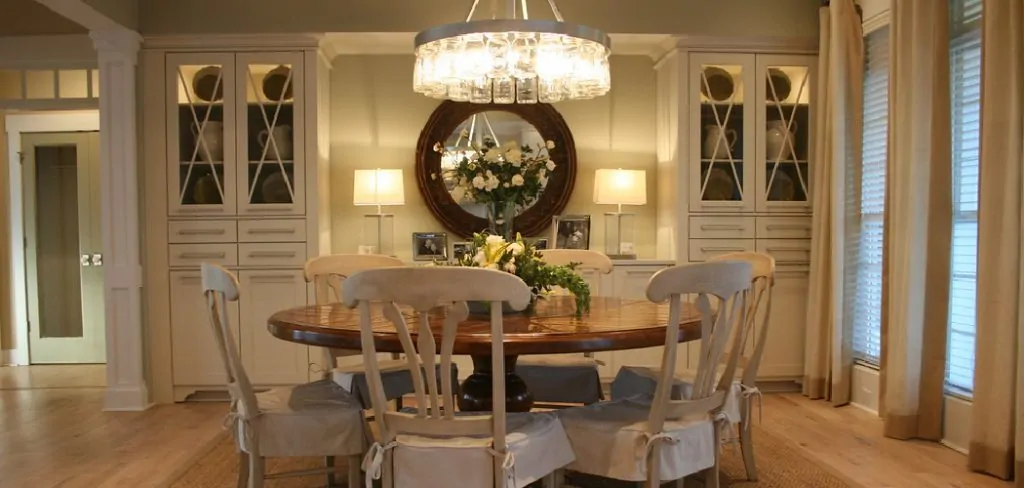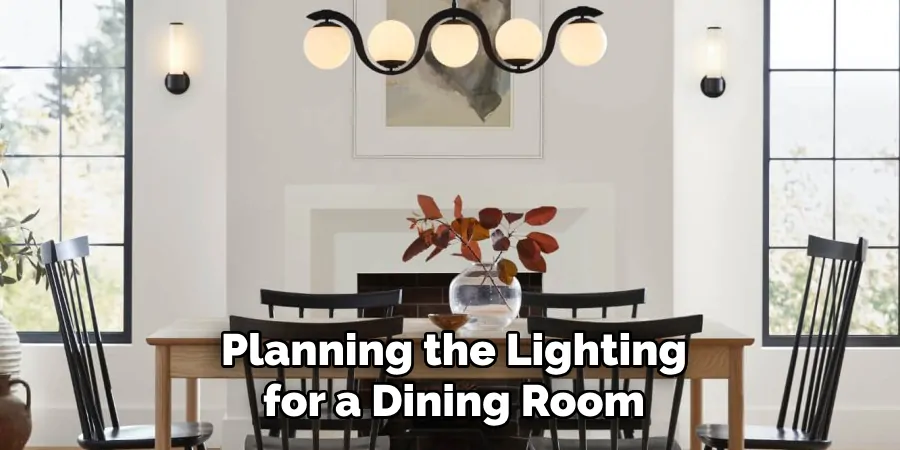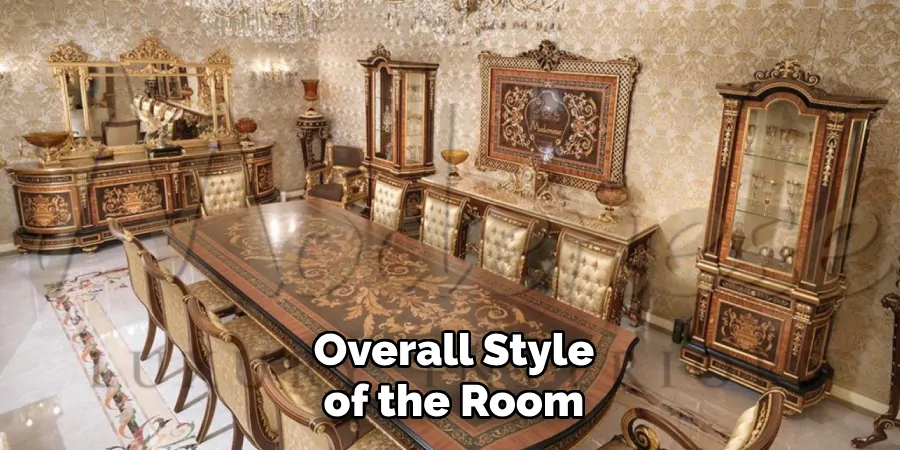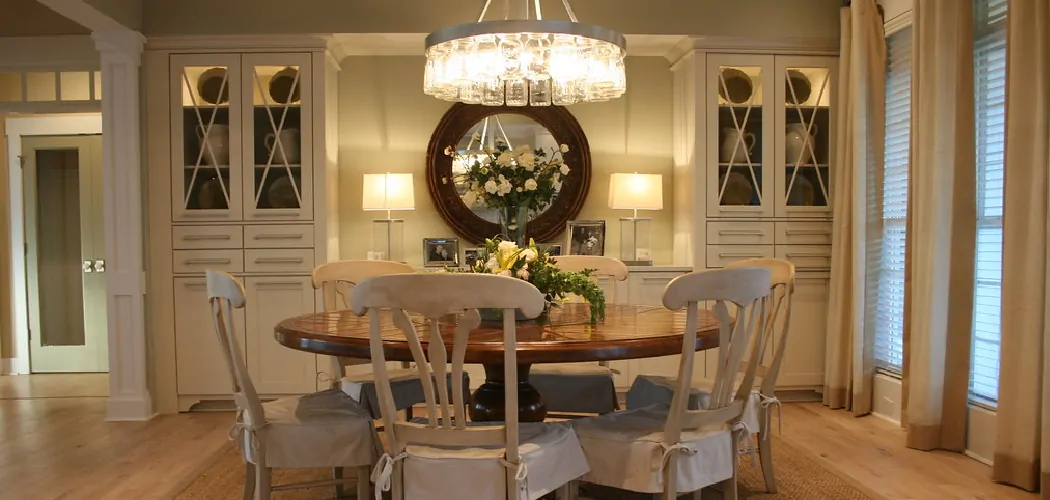Illuminating a dining room is a delicate art that extends beyond mere functionality, as it plays a crucial role in setting the ambiance for meals and social gatherings. Crafting the perfect lighting scheme involves considering both aesthetics and practicality to create a welcoming and visually appealing space.

In this article, we explore how to light a dining room, offering insights into the strategic placement of fixtures, the choice of lighting styles, and the incorporation of dimmers for customizable atmospheres.
From pendant lights and chandeliers to wall sconces and accent lighting, this guide aims to empower homeowners and designers with the knowledge needed to transform a dining room into a well-lit haven where meals are savored, conversations flow, and the overall atmosphere is beautifully illuminated.
Importance of Proper Lighting in Dining Rooms
Proper lighting in dining rooms is not merely about ensuring the space is bright enough to see the meal in front of you. It’s about creating an environment that enhances the dining experience, encourages social interaction, and complements the aesthetics of the room.
The right lighting can transform mealtime into a special event, elevating the mundane into something memorable. It sets the mood, whether it’s a romantic dinner for two, a lively family gathering, or an elegant soiree.
Furthermore, lighting can highlight the room’s best features, from the texture of a beautifully set table to the colors of a well-planned interior design. In essence, it plays a pivotal role in making a dining room not just a place to eat, but a space to connect, relax, and enjoy.
Impact of Lighting on Ambiance
The impact of lighting on the ambiance of a dining room cannot be overstated. Lighting directly influences the mood and atmosphere, creating a backdrop for every meal and gathering. Warm, soft lighting invites intimacy and comfort, making guests feel welcomed and at ease, while brighter lights can energize the space, fueling lively discussions and interactions.
The choice of light fixtures themselves also contributes to the room’s character, with elegant chandeliers suggesting sophistication and pendant lights echoing modern sleekness.
By carefully selecting and positioning lights, homeowners can craft an ambiance that reflects not just the physical, but also the emotional tone they wish to set for their dining room. Whether aiming for a cozy, serene setting or a vibrant, dynamic atmosphere, lighting is the essential tool in the alchemy of ambiance creation.
Key Factors to Consider When Lighting a Dining Room
When planning the lighting for a dining room, several key factors must be taken into consideration to ensure the space is both beautiful and functional. First and foremost, Layering of Light is essential; combining ambient, task, and accent lighting creates a versatile environment that can adapt to any occasion.

Scale and Proportion of light fixtures in relation to the dining table and room size also play a critical role, as an oversized chandelier or too small pendant lights can disrupt the room’s harmony.
The Height of Fixtures above the dining table needs careful adjustment to avoid glare and ensure a comfortable illumination level for diners. Additionally, the Color Temperature of the bulbs can significantly affect the atmosphere, with warmer tones inviting relaxation and cooler tones stimulating alertness.
Lastly, considering the Style and Decor of the dining room is paramount, as the lighting should complement the overall aesthetic, not clash with it. By mindfully addressing these factors, a dining room can achieve a balance of form and function, providing an ideal setting for memorable dining experiences.
Evaluation of The Dining Room’s Dimensions and Shape
Before selecting fixtures and deciding on the lighting scheme, it’s imperative to evaluate the dining room’s dimensions and shape. This assessment serves as a foundation for understanding how light will interact with the space, influencing both the intensity and distribution of light needed to achieve the desired effect.
A rectangular dining room may benefit from a linear arrangement of lights or a series of pendants to mimic the table’s shape, ensuring even illumination. In contrast, a square or circular room could be better suited to a central lighting fixture, such as a chandelier, to anchor the space and distribute light evenly.
The room’s height also plays a crucial role, as higher ceilings may require more powerful lighting or strategically placed accent lights to fill the volume without creating stark shadows.
Taking accurate measurements and considering the geometrical properties of the dining area not only aids in selecting the proper lighting fixtures but also in optimizing their placement to enhance both functionality and aesthetic appeal.
10 Methods How to Light a Dining Room
1. Assess the Room Size and Layout:
Begin by understanding the dimensions and layout of your dining room. Consider the size of the table, the height of the ceiling, and the overall spatial arrangement. This assessment will guide decisions regarding the number and types of fixtures needed for effective lighting. Consider the position and size of windows, as well as any other potential sources of natural light that can be complemented by artificial lighting.

In addition, think about the activities that will take place in the dining room. Will it primarily be used for formal dinners or casual family gatherings? The type of lighting needed may vary based on these activities. For example, a dimmer switch can provide adjustable lighting for different occasions and create a more intimate atmosphere when needed.
2. Choose the Right Chandelier or Pendant Lights:
The centerpiece of dining room lighting is often a chandelier or pendant lights suspended above the table. Select a fixture that complements the room’s aesthetic and provides adequate illumination for dining activities.
Ensure the size is proportionate to the table and space, allowing for a balanced and harmonious look. However, it’s important to consider the different types of chandeliers and pendant lights available in order to make the best choice for your dining room.
3. Determine the Appropriate Hanging Height:
Pay attention to the hanging height of the chandelier or pendant lights. Ideally, these fixtures should be positioned approximately 30 to 36 inches above the dining table surface.
Adjustments can be made based on the fixture’s size and the overall height of the room to achieve optimal lighting and visual appeal. Though this measurement may seem low, it allows for a comfortable and intimate dining experience without obstructing the view across the table.
One important factor to consider when determining the hanging height is the size of the room and the chandelier or pendant lights. In a bigger room, you may need to hang the fixture slightly higher so that it doesn’t overpower the space. Similarly, if your dining table is longer than average, you may need to raise the fixture slightly as well.

Another aspect to keep in mind is the overall style of the room. For a more casual and relaxed atmosphere, you may want to lower the hanging height of the chandelier or pendant lights. On the other hand, for a more formal dining area, it’s recommended to hang the fixture slightly higher for a grander effect.
4. Incorporate Wall Sconces for Ambient Lighting:
Introduce wall sconces to enhance ambient lighting in the dining room. Strategically placed sconces can contribute to a well-lit atmosphere and create a balanced distribution of light. Consider installing dimmer switches for sconces to adjust the brightness level based on the desired mood.
In addition, wall sconces can also serve as decorative elements in the dining room. They come in various designs and styles that can complement the overall aesthetic of the space. Choose sconces with warm tones or unique shapes to add a touch of personality to the room.
Moreover, wall sconces offer flexibility in terms of placement. They can be installed at different heights and positions, depending on the layout of the room. This allows for customizable lighting options and can help highlight specific areas or features in the dining room.
To further enhance the impact of wall sconces, pair them with mirrors to create a brighter and more spacious ambiance. The reflective surface of mirrors can bounce off light from the sconces, creating an illusion of a larger and brighter space.
5. Add Task Lighting with Buffet Lamps or Sideboard Lights:
To address specific tasks such as serving or setting the table, integrate task lighting with buffet lamps or sideboard lights. These fixtures not only serve a functional purpose but also contribute to the overall aesthetic, adding layers to the room’s lighting design. Buffet lamps or sideboard lights can be placed on the buffet table, credenza, or sideboard to provide focused light in a specific area.

Task lighting is essential in any room and can significantly enhance the functionality of the space. In a dining room, task lighting is especially important as it allows for specific tasks such as serving and setting the table to be completed with ease.
Buffet lamps or sideboard lights come in a variety of styles and designs, making it easy to find one that complements the existing decor. For traditional dining rooms, opt for buffet lamps with elegant bases and shades, while modern spaces may benefit from sleek and minimalistic designs. Consider the height of the lamp when placing it on a sideboard or buffet table – it should provide enough light without obstructing the view across the table.
Pairing buffet lamps or sideboard lights with dimmer switches allows for greater control over the intensity of the light, making it perfect for creating a relaxed ambiance during meal times. Additionally, consider using LED bulbs in these fixtures to save energy and add longevity to the lighting design.
6. Consider Recessed Lighting for General Illumination:
Implement recessed lighting to provide general illumination throughout the dining room. Strategically spaced recessed lights can evenly distribute light, eliminating shadows and enhancing the overall visibility in the space. Use dimmer switches to control the intensity of recessed lighting based on different occasions.

Recessed lighting is a popular choice for general illumination in many rooms, including dining rooms. They are installed into the ceiling and provide an overall ambient light that can be easily adjusted with dimmer switches. These lights are also great for creating a modern, sleek look and can work well with any style of dining room decor.
When choosing recessed lighting for your dining room, consider the size and layout of the space. Larger rooms may require more recessed lights to effectively illuminate the entire area, while smaller rooms can benefit from fewer fixtures.
Additionally, think about how you will use your dining room and what type of lighting would be most useful. For example, if you often host dinner parties or use the space for activities like board games or homework, you may want to install brighter recessed lights that can be dimmed for more intimate occasions.
7. Utilize Dimmers for Versatility:
Install dimmer switches for various lighting fixtures in the dining room, including chandeliers, pendants, wall sconces, and recessed lights. Dimmers offer flexibility in adjusting the brightness levels to suit different activities, creating a dynamic and customizable ambiance for casual dinners or formal gatherings.
In addition to providing versatile lighting options, dimmers also help save energy and extend the lifespan of light bulbs. By reducing the amount of electricity flowing through the bulb, dimmers can significantly reduce your energy consumption and lower your utility bills. They also minimize wear and tear on the bulb, helping it last longer before needing replacement.
8. Opt for Layered Lighting:
Embrace a layered lighting approach by combining different types of fixtures to create depth and dimension. Layered lighting involves a combination of ambient, task, and accent lighting to fulfill various functional and aesthetic needs. Experiment with different combinations to achieve the desired effect.

For instance, blend your overhead light fixtures with wall sconces and table lamps to create warm and inviting spaces. Additionally, by using dimmers and smart lighting systems, you can easily adjust the intensity of light according to your needs.
9. Introduce Accent Lighting for Visual Interest:
Enhance the visual interest of your dining room by incorporating accent lighting. This could include spotlights on artwork or decorative elements, highlighting architectural features, or using LED strips to create a subtle glow. Accent lighting adds a touch of sophistication and draws attention to specific areas within the room. It also creates a layered lighting effect, making the space feel more dynamic and inviting.
Moreover, accent lighting can also serve as a functional element in your dining room. For example, using task lighting above the dining table can make it easier to see and enjoy your meals, especially during evening gatherings or intimate dinners.
10. Pay Attention to Bulb Color Temperature:
Carefully select the color temperature of the bulbs used in your dining room fixtures. Warm white tones, around 2700K, create a cozy and inviting atmosphere suitable for dining. Experiment with different bulb types, such as incandescent, LED, or Edison bulbs, to find the right balance between warmth and brightness.
In addition to the color temperature, consider the intensity of the bulbs as well. Dimmer bulbs can help set a more intimate and relaxed mood for dining, while brighter bulbs may be better for tasks like reading or hosting a large dinner party.
Another factor to keep in mind is the color rendering index (CRI) of the bulbs. This measures how accurately colors appear under the light source. For a vibrant and welcoming dining room, opt for bulbs with a CRI of 80 or higher.
Common Mistakes to Avoid When Choosing Dining Room Lighting
One common mistake to avoid is overlooking the size and scale of the lighting fixtures in relation to the dining room table and the room itself. A chandelier that is too large can overwhelm the space, while one that is too small may look inconsequential and fail to provide adequate illumination. It is crucial to find a balance that complements the dimensions of both the room and the dining table.
Another error often made is neglecting the overall style and decor of the dining room. Selecting lighting that clashes with the room’s aesthetic can disrupt the harmony of the space. Whether your dining room exudes a modern, traditional, or eclectic vibe, ensure the lighting fixtures enhance and echo the existing decor.

Lastly, failing to incorporate multiple sources of light is a mistake that can affect the functionality and ambiance of the dining room. Relying solely on a single overhead light can create harsh shadows and uneven lighting. Instead, consider layering different types of lighting, such as ambient, task, and accent lighting, to achieve a versatile and inviting dining atmosphere.
Conclusion
In conclusion, illuminating a dining room is more than just a practical consideration; it’s an art form that sets the stage for memorable meals and gatherings. By carefully balancing ambient, task, and accent lighting layers, individuals can create a dining space that is both functional and inviting.
Selecting the right light fixtures, considering placement and installation, and incorporating dimmers and controls all play integral roles in crafting the desired ambiance. Additionally, the thoughtful addition of decorative elements adds personality and charm to the dining room environment.
Regular maintenance ensures that the lighting scheme remains effective and aesthetically pleasing over time. Hopefully, this article gave you some helpful tips about how to light a dining room successfully, so now that you have the proper knowledge on how to get the job done, why not give it a try today?

